Related Research Articles

The Boeing CIM-10 BOMARC was a supersonic ramjet powered long-range surface-to-air missile (SAM) used during the Cold War for the air defense of North America. In addition to being the first operational long-range SAM and the first operational pulse doppler aviation radar, it was the only SAM deployed by the United States Air Force.

The Semi-Automatic Ground Environment (SAGE) was a system of large computers and associated networking equipment that coordinated data from many radar sites and processed it to produce a single unified image of the airspace over a wide area. SAGE directed and controlled the NORAD response to a possible Soviet air attack, operating in this role from the late 1950s into the 1980s. Its enormous computers and huge displays remain a part of cold war lore, and after decommissioning were common props in movies such as Dr. Strangelove and Colossus, and on science fiction TV series such as The Time Tunnel.

North American Aerospace Defense Command, known until March 1981 as the North American Air Defense Command, is a combined organization of the United States and Canada that provides aerospace warning, air sovereignty, and protection for Canada and the continental United States. Headquarters for NORAD and the NORAD/United States Northern Command (USNORTHCOM) center are located at Peterson Space Force Base in El Paso County, near Colorado Springs, Colorado. The nearby Cheyenne Mountain Complex has the Alternate Command Center. The NORAD commander and deputy commander (CINCNORAD) are, respectively, a United States four-star general or equivalent and a Canadian Lieutenant-general or equivalent.
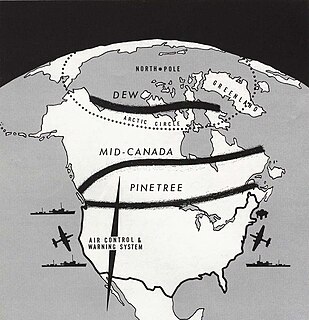
The Pinetree Line was a series of radar stations located across the northern United States and southern Canada at about the 50th parallel north, along with a number of other stations located on the Atlantic and Pacific coasts. Run by North American Aerospace Defense Command (NORAD), over half were staffed by United States Air Force personnel with the balance operated by the Royal Canadian Air Force. The line was the first coordinated system for early detection of a Soviet bomber attack on North America, but before the early 1950s radar technology quickly became outdated and the line was in full operation only for a short time.
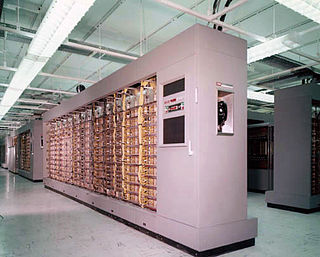
The AN/FSQ-7 Combat Direction Central, referred to as the Q7 for short, was a computerized command and control system for Cold War ground-controlled interception used in the USAF Semi-Automatic Ground Environment (SAGE) air defense network.

Aerospace Defense Command was a major command of the United States Air Force, responsible for continental air defense. It was activated in 1968 and disbanded in 1980. Its predecessor, Air Defense Command, was established in 1946, briefly inactivated in 1950, reactivated in 1951, and then redesignated Aerospace rather than Air in 1968. Its mission was to provide air defense of the Continental United States (CONUS). It directly controlled all active measures, and was tasked to coordinate all passive means of air defense.
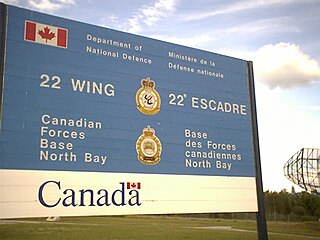
The AN/FSQ-32 SAGE Solid State Computer was a planned military computer central for deployment to Super Combat Centers in nuclear bunkers and to some above-ground military installations. In 1958, Air Defense Command planned to acquire 13 Q-32 centrals for several Air Divisions/Sectors.

The 26th Air Division is an inactive United States Air Force organization. Its last assignment was with Air Defense Tactical Air Command, assigned to First Air Force, being stationed at March Air Force Base, California. It was inactivated on 30 September 1990.
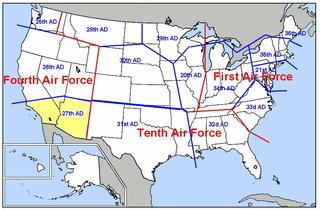
The 27th Air Division was a United States Air Force numbered air division and the geographic Air Defense Command region controlled by the 27th AD. Its last assignment was with Air Defense Command (ADC)'s Tenth Air Force, at Luke Air Force Base, Arizona. It was inactivated on 19 November 1969.
Canadian Forces Station Lowther is a closed General Surveillance Radar station. It is located 12.7 miles (20.4 km) east-southeast of Mattice-Val Côté, Ontario. It was closed in 1987.

The Boston Air Defense Sector (BADS) is an inactive United States Air Force Air Defense Command (ADC) organization. Its last assignment was with the ADC 26th Air Division at Hancock Field, New York.
The SAGE radar stations of Air Defense Command were the military installations operated by USAF squadrons using the 1st automated air defense environment and networked by the SAGE System, a computer network. Most of the radar stations used the Burroughs AN/FST-2 Coordinate Data Transmitting Set (CDTS) to automate the operator environment and provide radar tracks to sector command posts at SAGE Direction Centers (DCs), e.g., the Malmstrom Z-124 radar station was co-located with DC-20. The sector/division radar stations were networked by DCs and Manual Control Centers to provide command, control, and coordination for ground-controlled interception of enemy aircraft by interceptors such as the F-106 developed to work with the SAGE System.

Canadian Forces Station Beausejour is a closed General Surveillance Radar station. It is located 45.1 miles (72.6 km) east-northeast of Winnipeg, Manitoba. It was closed in 1986.

The Fort Heath radar station was a USAF radar site and US Army Missile Master installation of the joint-use site system (JUSS) for North American Air Defense at a former coastal defense site. The Cold War radar station had 2 USAF AN/FPS-6B height finding radars, 2 Army AN/FPS-6A height finders, an FAA ARSR-1 radar emplaced 1958-9, and an Army nuclear bunker. Arctic Towers were the pedestals for the FPS antennas and radomes, while the Air Route Surveillance Radar was on a 50-foot extension temperate tower adjacent to the Federal Aviation Administration building.
The GE AN/GPA-37 Course Directing Group was a USAF Cold War air defense command, control, and coordination system for weapons direction. During Air Defense Command's "Control Capability Improvement Program" to improve command guidance of manned aircraft, the AN/GPA-37 was "developed by the General Electric Heavy Military Electronic Equipment Department at Syracuse in conjunction with...Rome Air Development Center and the Electronics Research Laboratories of Columbia University." Used to process radar data, the system was to "track a potential enemy aircraft and direct intercepters [sic] into a position from which they can make their automatic firing runs", the system included the:

A Super Combat Center (SCC) was a planned Cold War command and control facility for ten NORAD regions/Air Divisions in Canada and the United States. For installation in nuclear bunkers, the command posts were to replace the last of the planned Air Defense Command Combat Centers to be built for vacuum tube AN/FSQ-8 Combat Control Centrals. The survivable SCCs were to use solid-state (transistorized) AN/FSQ-32 equipment which was to provide the Semi-Automatic Ground Environment for operators at 10 Air Divisions — 5 of the centers were to also serve as Air Defense Direction Centers ("SCC/DCs") for commanding ground-controlled interception in sectors of the 27th, 30th, 32nd, 33rd, and 35th Air Divisions. ADC's November 1958 plan to complete the hardened SCCs by April 1964 included fielding 3 additional AN/FSQ-32 systems above-ground for the Albuquerque, Miami, and Shreveport sectors.
An Air Defense Direction Center (ADDC) was a type of United States command post for assessing Cold War radar tracks, assigning height requests to available height-finder radars, and for "Weapons Direction": coordinating command guidance of aircraft from more than 1 site for ground-controlled interception. As with the World War II Aircraft Warning Service CONUS defense network, a "manual air defense system" was used through the 1950s Along with 182 radar stations at "the end of 1957, ADC operated … 17 control centers", and the Ground Observation Corps was TBD on TBD. With the formation of NORAD, several types of ADDCs were planned by Air Defense Command:

The Denver Air Defense Sector was a United States Air Force geographic area designated during the Cold War for both air defense and air traffic control, as well as the name of the planned military unit for conducting radar surveillance and fighter-interceptor operations in the sector area. The Denver ADS spanned the entire state of Colorado, nearly all of Utah, most of Wyoming and western Nebraska, and small parts of Kansas, Oklahoma, New Mexico, Arizona, and Nevada. Potential targets in the sector included the military/industrial facilities and urban civilian populations of the metropolitan areas at Salt Lake City, Cheyenne, Denver, and Colorado Springs..
NORAD Control Centers (NCCs) were Cold War "joint direction centers" for command, control, and coordination of ground-controlled interception by both USAF Air Defense Command (ADC) and Army Air Defense Command (ARADCOM). The Joint Manual Steering Group was "formed by the Army and Air Force in July 1957 to support…collocation" of USAF Air Defense Direction Centers and Army Air Defense Command Posts, which began after a January 28, 1958, ADC/ARADCOM meeting with NORAD to "collocate the Fairchild-Geiger facilities" Army contracts for 5 NCCs had been let by August 17, 1958, after 1956 DoD approval for collocation of interim "pre-SAGE semiautomatic intercept systems" and radar squadrons at 10 planned Army Missile Master AADCPs
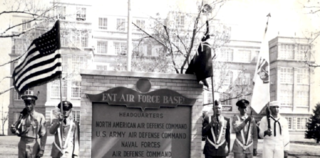
Continental Air Defense Command (CONAD) was a Unified Combatant Command of the United States Department of Defense, tasked with air defense for the Continental United States. It comprised Army, Air Force, and Navy components. It included Army Project Nike missiles anti-aircraft defenses and USAF interceptors. The primary purpose of continental air defense during the CONAD period was to provide sufficient attack warning of a Soviet bomber air raid to ensure Strategic Air Command could launch a counterattack without being destroyed. CONAD controlled nuclear air defense weapons such as the 10 kiloton W-40 nuclear warhead on the CIM-10B BOMARC. The command was disestablished in 1975, and Aerospace Defense Command became the major U.S. component of North American Air Defense Command (NORAD).
References
- 1 2 3 4 Preface by Buss, L. H. (Director) (14 April 1959). North American Air Defense Command and Continental Air Defense Command Historical Summary: July–December 1958 (Report). Directorate of Command History: Office of Information Services.
- 1 2 3 Preface by Buss, L. H. (Director) (1 November 1959). North American Air Defense Command and Continental Air Defense Command Historical Summary: January–June 1959 (Report). Directorate of Command History: Office of Information Services. "Project MADRE (Magnetic Drum Radar Equipment)."
- ↑ "ALERT" (PDF). Archived from the original (PDF) on January 27, 2017. Retrieved 2013-10-09.